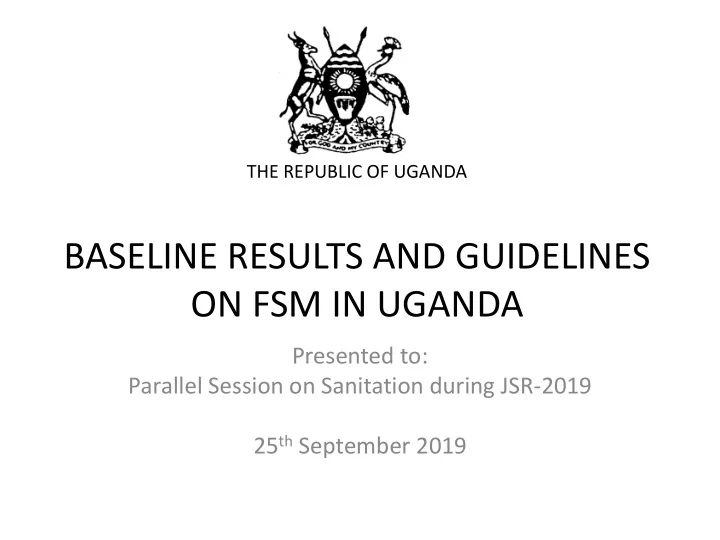

THE REPUBLIC OF UGANDA BASELINE RESULTS AND GUIDELINES ON FSM IN UGANDA Presented to: Parallel Session on Sanitation during JSR-2019 25 th September 2019
Presentation Outline • Background • Methodology • Targeted and requested data • Outcomes • Recommendations and way forward • GUIDELINES ON FSM o Content details
Background • FSTPs in operation and more under construction or planned – with inadequate o&m system • Apac FSTP was to be used as a case – to develop FSM guidelines for small towns • Undertaking No. 2 (on FSM baseline) and No. 3 (on O&M Framework) • MWE carried out a baseline for FSTPs and WWTPs across the country to inform the development of the Guidelines.
Methodology • Visited 46 Treatment Plants and administered a Questionnaire. 18 dedicated to FS. • Interviews with the operators
Target Data • General information (ID, location, name) • Status of the TP (operational or not, who operates, functionality) • Ownership information (land and the facility) • Implementation of TP project (developer, design report, investment costs, as-built drawings) • Type of the TP (FS or WW or combined, processes) • Treatment capacity of the TP • Monitoring of the TP(dumping records, effluent analysis, pond desludging etc) • Financial information • Information on Emptiers delivering FS to the TP
Results Table: Surveyed TPs Treated In Just Under Under Abandoned All TPs Influent operation Completed construction rehabilitation (not operated) FS 11 2 4 1 18 FS+WW 21 21 WW 5 1 1 7 All TPs 37 2 5 1 1 46
Results… Map of the surveyed TPs
OUTCOMES… Waste Water Treatment Plants (WWTPs) • All WWTPs are waste stabilization ponds. • Older than 10 years • Generally in fair or good condition • 50% of WWTPs do not have a sludge treatment – from ponds (need of drying beds ) • No operation data made available to analyze and confirm effluent quality (functionality).
Outcomes… FSTPs - different treatment processes • 13 plants have Planted Drying Beds (PDBs) • 4 plants consist of unplanted drying beds • 1 paved drying bed
Key Results - technical • Plant care issues; o Lack of adequate start-up systems o Insufficient water or sludge provision o Overloads o Uncontrolled weed growth • Clogging issues
Key Results – non technical • Lack of marketing (Low Demand for the FSM services) • No emptiers up country (in small towns) • No cost recovery by operators (no profit) • Lack of knowledge and training by the operators • No data management systems • Ownership (LG vs Operator) • Over design (haulage distance is still long) • Theoretical approach
WWTPs
PDBs
Micro FSTPs
Apac FSTP
Recommendations and way forward • Marketing the plants and available services during operation • Training of caretakers and setting up o&m system before operation • Provision of Subsidy by Government • Online system for data collection • Down sizing the designs • Put in place guidelines on FSM (to avoid theoretical approach)
GUIDELINES ON FSM • CONTENT o Purpose and Scope o Planning o Detailed Design o Authorizations for Construction and Operation o Construction o Handover & Agreements o Operation & Maintenance o Monitoring
Purpose and Scope of guidelines • Provide practical guidance to various key actors: ‒ Planners and decision makers , ‒ Designers and engineers, ‒ Utilities, ‒ Authorities in charge of monitoring and regulation enforcement, • Guidance on all key stages of a FSTP project lifecycle (Planning, Design, Authorizations, Construction, Handover and agreements, O&M, Monitoring) • For small FSTPs (up to about 5,000 m³ /a) in small towns.
Planning • Feasibility Studies o Emptying service available or concept to build it up • Scope: o Clarification of Responsibilities o Demand Assessment o FSTP Site Selection o Preliminary Cost Estimate
Detailed design • End product • Selection of the treatment processes • Design parameters • Environmental exposure risks
Authorizations for Construction and Operation • Effluent discharge permits • ESIA approvals • Environmental Audits
Construction • Current regulation apply (procurements and construction requirements)
Handover & Agreements • Land and Facility Ownership • Handover • FSTP operation (gazette etc) – involve the operator from the beginning • Agreement “FSTP operator / Pit Emptier(s) / LG
Operation and Maintenance • Staff requirements • Remuneration • Duties and tasks • Training • Standard operation procedures (Record keeping, dumping controls and bed feeding)
O&M- Apac case
Monitoring • Control that activities and assess the performance of the treatment plant. • Compliance with the regulations. • Provision of Data required • Staff performance • Quality Management Procedures
THANK YOU FOR LISTENING
Recommend
More recommend